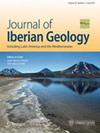来自喀麦隆盆地(Ágreda,西班牙)成熟地层的一个新的脊椎动物组合:侏罗纪/白垩纪边界的多样性意义
IF 1.5
4区 地球科学
Q2 GEOLOGY
引用次数: 0
摘要
Ribota遗址(Ágreda, Soria, Spain)是Matute组(Tithonian-Berriasian)中的一个新地点,由几个碳酸盐层组成,非常丰富的大型脊椎动物遗骸。化石显示石英代替了原始的生物磷灰石,并在湖相灰岩床中被发现为凸出的正面浮雕。这种类型的保护使得在超过10公顷的露头中发现了大约100个脊椎动物的骨头。已经鉴定出了骨鱼目动物(关节部分骨骼、颅骨材料和分离的颅后骨骼和鳞片)、鳄鱼形动物(分离的颅骨材料、分离的牙齿、椎骨和骨皮)、海龟(部分甲壳和骨质,但也有分离的板)和翼龙(颅骨和阑尾部分)。已经收集了大约80个标本,对部分标本(35个标本)的初步研究已经确定了至少5个不同的分类群:Halecomorphi indet。我不知道。Goniopholididae indet;, Testudinata indet。和翼手亚目。这个新遗址是这段时间内保存在完全湖泊环境中的少数遗址之一,所以这些脊椎动物的组合是独特的,由可能生活在湖周围和湖中的不同动物组成。它们以水生和两栖脊椎动物为主,是在远离湖岸线的湖泊环境中由磨蚀作用形成的。这些大型脊椎动物组合为研究伊比利亚盆地裂谷系侏罗纪/白垩纪过渡时期动物生态系统的多样性提供了新的数据。本文章由计算机程序翻译,如有差异,请以英文原文为准。
A new vertebrate assemblage from the matute formation of the Cameros Basin (Ágreda, Spain): implications for the diversity during the jurassic/cretaceous boundary
Abstract The Ribota site (Ágreda, Soria, Spain) is a new locality in the Matute Formation (Tithonian–Berriasian) composed of several carbonate layers, outstandingly rich in macrovertebrate remains. Fossils show an unusual replacement of the original bioapatite by quartz, and are found as positive reliefs protruding from lacustrine limestone beds. This type of conservation has allowed the identification of around one hundred vertebrate bone accumulations in an outcrop of more than 10 hectares. Osteichthyans (articulated partial skeletons, cranial material, and isolated postcranial bones and scales), crocodylomorphs (disarticulated cranial material, isolated teeth, vertebrae and osteoderms), turtles (partial carapaces and plastra, but also isolated plates) and pterosaurs (cranial and appendicular elements) have been identified. Around 80 specimens have been collected and a preliminary study of part of the collection (35 specimens) has allowed the identification of at least 5 different taxa: Halecomorphi indet., Neoginglymodi indet., Goniopholididae indet., Testudinata indet., and Pterodactyloidea indet. This new site represents one of the few sites from this time interval preserved in a fully lacustrine environment, so these vertebrate assemblages are unique and composed of different animals that presumably lived around and within the lake. They are dominated by aquatic and amphibian vertebrates and was formed by attrition in this lacustrine environment, possibly far from the lake shoreline. These macrovertebrate assemblages provide new data about the diversity in the faunal ecosystems from the Jurassic/Cretaceous transition of the Iberian Basin Rift System.
求助全文
通过发布文献求助,成功后即可免费获取论文全文。
去求助
来源期刊

Journal of Iberian Geology
地学-地质学
CiteScore
2.60
自引率
7.70%
发文量
18
审稿时长
>12 weeks
期刊介绍:
The Journal of Iberian Geology will consider for publication original, high-quality papers (including research articles, reviews and brief communications) dealing with different aspects of Earth Sciences in Latin America and the Caribbean, as well as the Mediterranean region, including Geology, Paleontology, Geophysics and Geochemistry. The journal welcomes research papers with regional appeal, but these should present results of international interest. The Journal accepts collections of selected original papers on topics within these scopes, which will be published as edited monographic issues.
 求助内容:
求助内容: 应助结果提醒方式:
应助结果提醒方式:


